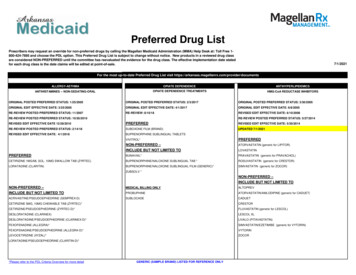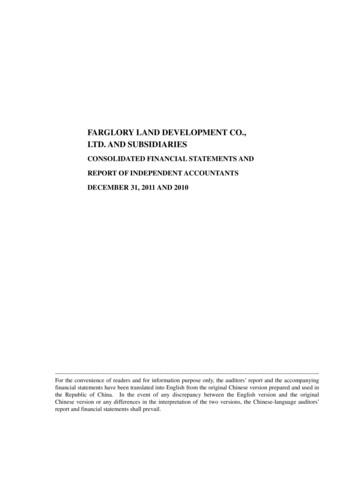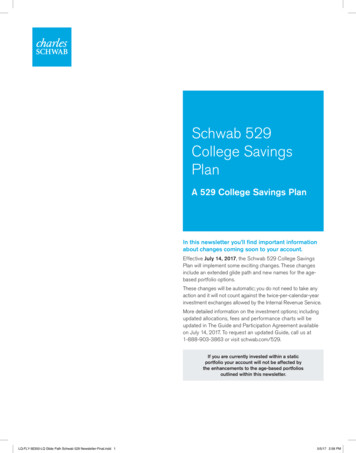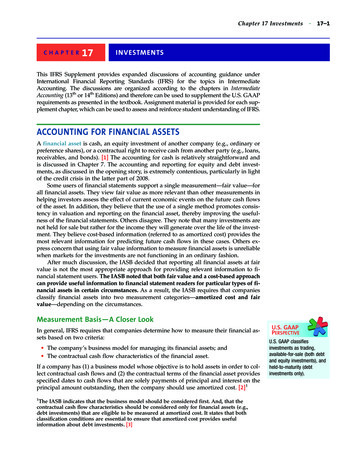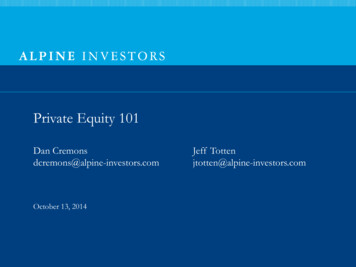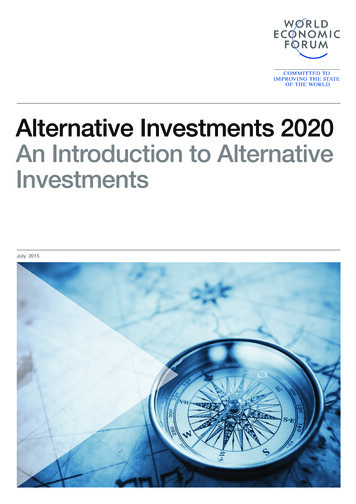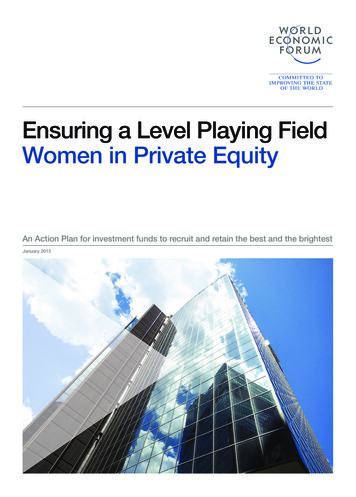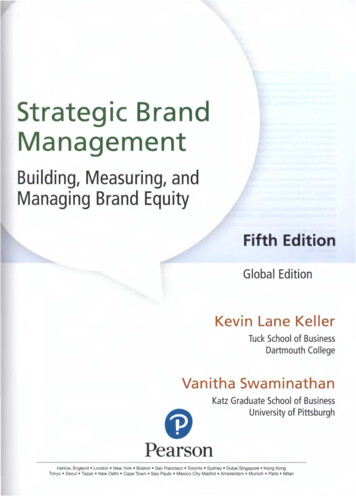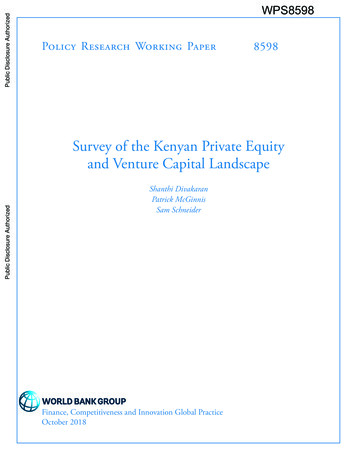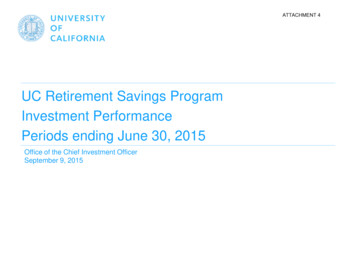
Transcription
Presenting a live 90-minute webinar with interactive Q&AStructuring Preferred Equity Investments in RealEstate Ventures: True Equity vs. "Debt-Like" EquityNegotiating Deal Terms, Investor Return, Change inControl Provisions; Assessing Remedies, Tax, Bankruptcy IssuesTUESDAY, NOVEMBER 22, 20161pm Eastern 12pm Central 11am Mountain 10am PacificToday’s faculty features:Loryn D. Arkow, Partner, Stroock & Stroock & Lavan, Los AngelesDiana M. Brummer, Partner, Stroock & Stroock & Lavan, New YorkJon S. Ziefert, Special Counsel, Stroock & Stroock & Lavan, Los AngelesThe audio portion of the conference may be accessed via the telephone or by using your computer'sspeakers. Please refer to the instructions emailed to registrants for additional information. If youhave any questions, please contact Customer Service at 1-800-926-7926 ext. 10.
Tips for Optimal QualityFOR LIVE EVENT ONLYSound QualityIf you are listening via your computer speakers, please note that the qualityof your sound will vary depending on the speed and quality of your internetconnection.If the sound quality is not satisfactory, you may listen via the phone: dial1-866-755-4350 and enter your PIN when prompted. Otherwise, pleasesend us a chat or e-mail sound@straffordpub.com immediately so we canaddress the problem.If you dialed in and have any difficulties during the call, press *0 for assistance.Viewing QualityTo maximize your screen, press the F11 key on your keyboard. To exit full screen,press the F11 key again.
Continuing Education CreditsFOR LIVE EVENT ONLYIn order for us to process your continuing education credit, you must confirm yourparticipation in this webinar by completing and submitting the AttendanceAffirmation/Evaluation after the webinar.A link to the Attendance Affirmation/Evaluation will be in the thank you emailthat you will receive immediately following the program.For additional information about continuing education, call us at 1-800-926-7926ext. 35.
Program MaterialsFOR LIVE EVENT ONLYIf you have not printed the conference materials for this program, pleasecomplete the following steps: Click on the symbol next to “Conference Materials” in the middle of the lefthand column on your screen. Click on the tab labeled “Handouts” that appears, and there you will see aPDF of the slides for today's program. Double click on the PDF and a separate page will open. Print the slides by clicking on the printer icon.
INTRODUCTION 76414426v1Introductions of Loryn D. Arkow, Diana M. Brummer, and Jon S. ZiefertOutline of the Presentation:a) Basic Building Blocks of Capital Stackb) Need for Preferred Equity and Mezzanine Loansc) Structural Subordinationd) Preferred Equity Structures(i) “Hard” Preferred Equity(ii) “Soft” Preferred Equitye) Benefits and Risks of Preferred Equity Structures(i) Preferred Equity vs. Mezzanine Debt(ii) Preferred Equity vs. Common Equityf) Defaults, Change in Controlg) Key Provisions(i) Joint Venture Agreements(ii) Sample Distribution Waterfalls(iii) Otherh) Certain Preferred Equity Protectionsi) Intercreditor Issuesj) Certain Tax Mattersk) Fiduciary Issuesl) Distribution Riskm) Recharacterizationn) Conclusion5
Preferred Equity Structures Term “Preferred Equity” is broad and can meandifferent things. Sometimes it refers to what iseffectively a mezzanine loan equivalent (“hard”).Other times it refers to equity with a prioritypreferred return, but that is in all other ways thesame as common equity (“soft”). Preferred equity structures span a continuum withdebt-like preferred equity on the one end andcommon-equity-like preferred equity on the other.76414426v16
Basic Building Blocks of the Capital StackSenior PriorityMezzanine Loan5-25%Preferred Equity5-25%Common Equityincluding Sponsor Equity10-30%76414426v1Subordinate to LoanSenior to Common EquityLast in Line7
Basic Building Blocks of the Capital Stack– Mortgage LoanMortgage:Loan to property ownersecured by a first mortgage lienon real property.(Typically 50-70% of capitalstack)76414426v18
Mortgage Loan Structure ChartSponsor/ManagingMemberProperty OwnerSPEMortgage LoanMortgageLenderReal Estate76414426v19
Basic Building Blocks of the CapitalStack – Mezzanine LoanMezzanineLoan:Loan to equity owner(s) ofproperty owner, secured by apledge of equity interests inproperty owner.(Typically 5-20% of capitalstack)76414426v110
Mezzanine Loan ezzanine HoldingCompany SPEMezzanine LoanMezzanine LenderPledge of membershipinterests in PropertyOwner SPEProperty OwnerSPEMortgage LoanIntercreditor AgreementMortgageLenderReal Estate76414426v111
Basic Building Blocks of the CapitalStack – “Hard” Preferred Equity“Hard”PreferredEquity:Equity investment in property owner (or in direct or indirectequity owner of property owner). Preferred equity investmentis structured much like a loan where (i) “interest” in the formof a preferred return on the investment is required to be paidmonthly by the sponsor regardless of available property cashflow; (ii) the entire investment is required to be paid by acertain maturity date; (iii) default rate “interest” and penaltiesare assessed against the sponsor in the event payments are notmade timely; and (iv) a default in the repayment of investmentpotentially results in the loss of management and/or ownershipcontrol by the sponsor in the company in favor of the investoror other third-party. An “interest” reserve or letter of credit issometimes used to insure the preferred return is paid.(Typically 5-25% of Capital Stack)CommonEquity:Equity with a priority of payment subordinate to the preferredequity and payment dependent on available cash flow(Typically 10-30% of Capital Stack)76414426v112
“Hard” Preferred Equity StructureSponsor/ManagingMemberPledge of membershipinterests in Property OwnerSPE (sometimes)Property Owner SPEPreferred MemberMortgageLenderReal Estate76414426v113
Basic Building Blocks of the CapitalStack – “Soft” Preferred Equity“Soft”PreferredEquity:Equity Investment in property owner or in director indirect equity owner of property owner.Preferred equity not secured, but enjoys somelevel of preferred return, priority of paymentand other rights.(Typically 5-25% of Capital Stack)CommonEquity:Equity with a priority of payment subordinate to thepreferred equity.(Typically 10-30% of Capital Stack)76414426v114
“Soft” Preferred Equity StructureSponsor/ManagingMemberNon-Managing Member(Preferred Equity)Property Owner SPEMortgageLenderUnderlying Real Estate76414426v115
Need for Mezzanine Loans andPreferred Equity Equity or Value Gap: Over leveraged properties to berefinanced. Prohibitions And Restrictions: CMBS and othermortgage lender prohibitions on junior mortgages. HVCRE Regulations: Mortgage loan borrower musthave contributed at least 15% of the real estate’s“appraised as completed” value prior to advance offunds by the bank. Sponsor Desire for Greater Leverage: Acquiring theasset with minimum of equity or cash out.76414426v116
Structural Subordination Mortgage: MezzanineLoan:76414426v1Senior Position. Behind onlypre-existing liens and superpriority liens (e.g., local realestate taxes).Subordinate to all propertyowner debt. Senior to otherdebt of mezzanine borrower (atleast with respect to pledgedequity collateral).17
Structural Subordination –Continued PreferredEquity: CommonEquity: Risks/Rewards:76414426v1Subordinate to all mortgage andmezzanine debt. Senior to commonequity.Subordinate to all debt, and, to the extentprovided by its terms, Preferred Equity.Risks and returns are highest forcommon equity, then preferred equity(varies), then mezzanine loans and lastly,mortgage loans. Note: “hard” preferredequity and mezzanine loans have similarreturns.18
Preferred Equity Structures – “Hard” 76414426v1Debt Equivalent. Looks and acts a lot like a mezzanine loan:A) Fixed monthly distributions to be paid regardless of cash flow.B) Fixed, mandatory redemption date.C) Sponsor carve-out guaranty and environmental indemnity in favor of Preferred EquityInvestor.D) “Events of Default” (e.g., failure to pay preferred return or preferred equity investment whendue; breach of guarantor financial covenants; other material covenant breaches.E) Preferred Equity Investor has removal right (including for failure of timely distributions).F) Major decisions requiring Preferred Equity Investor approval similar to mezzanine loancovenants.G) Insufficient cash flow or property’s appraised value certain can trigger removal of Sponsor.H) Sponsor’s interest pledged to Preferred Equity Investor – possible forfeiture of Sponsor’sinterest if Preferred Equity not redeemed by mandatory redemption date. Unusual. Removalas manager and forced sale more common.I) Failure of timely distribution or other default results in default preferred equity rate (20 %not atypical).J) Generally, Preferred Equity Investor has no share in residual income or increased propertyvalue.K) Generally, Preferred Equity Investor has no share of losses outside of reversal of priorallocated income, although often operating agreement may provide that the Preferred EquityInvestor’s interest is to be treated as debt for tax purposes.L) Preferred Investor has no obligation to contribute additional capital.M) Preferred Investor may be entitled to early redemption premium (i.e., a minimum preferredreturn).19
Preferred Equity Structures – “Soft” “True” Equity. May have any number of different features:A) Often a stated preferred return, paid first, but only out of cash flow/available capitalproceeds (Sponsor may have similar stated return which may be subordinate or even paripassu).B) After stated return, cash flow/capital event proceeds allocated based upon relative capitalcontributions. Preferred Equity Investor shares in the residual. Typically Sponsorreceives a promote.C) Promote may be paid before all capital returned (but after stated return paid) or onlyafter all capital returned and stated return paid. Clawback of promote if Preferred EquityInvestor does not receive stated return.D) Preferred Equity Investor participates in profits and losses.E) Removal right for “bad acts”; may also have default or performance-based removal, butstandards not as severe as “hard” preferred equity. Removal leads to loss ofmanagement rights of Sponsor (but not forfeiture). Sponsor may retain consent rightsover certain major decisions (e.g., sale of the Property) and voluntary bankruptcyfollowing removal. Sponsor needs to protect against self dealing transactions byPreferred Equity Investor following removal.F) Deadlocks – (i) one member has tie-breaker vote; (ii) buy-sell provision; (iii)maintenance of status quo.G) Preferred Equity Investor may have put or forced sale right after stated lock-out period.76414426v120
Benefits and Risks ofPreferred Equity to Sponsor(i) Preferred Equity vs. Mezzanine Loan(a) Benefits to Sponsor: Easier to obtain mortgage lender consent to preferred equity Depending on structure of Preferred Equity, (x) no fixed payments or maturity and(y) limited sharing of upside with investor(b) Risks to Sponsor: No protection of UCC (potential for expedited loss of control) Sponsor is typically sole carve-out guarantor Cost of funds may be higher(ii) Preferred Equity vs. Common Equity(a) Benefits to Sponsor: Promote structure Ability to operate within stated business plan and budget without undueinterference(b) Risks to Sponsor: Preferred Equity Investor member’s major decision and potential control right Potential buy-sell or forced sale76414426v121
Benefits and Risks of Preferred Equity to thePreferred Equity Investor(i) Preferred Equity vs. Mezzanine Loan:(a) Benefits to the Preferred Equity Investor Potentially greater return Potential efficiency of taking control Permitted by mortgage lender(b) Risks to the Preferred Equity Investor No security Litigation risk Upon take-over, Sponsor may remain a partner/member Recharacterization for tax purposes(ii) Preferred Equity vs. Common Equity:(a) Benefits to the Preferred Equity Investor Typically a preferred return and senior return of capital Management rights Ability to take control under defined circumstances Potential to exit via buy-sell, put or forced sale(b) Risks to the Preferred Equity Investor Potentially lower return because there may be no participation in the residual upside Depending on structure, potentially less day to day control Potential of being forced out of investment early (e.g., by a buy-sell or call provision)76414426v122
Material Defaults & Remedies A Preferred Equity Investor has certain remedies forvarious Sponsor defaults, including:76414426v1(1) Failure to timely fund monthly payments and other timesensitive payments(2) Loss of key officers of the Sponsor(3) Failure to fund required capital(4) Non-performance of obligations (for example, Sponsor notobtaining the necessary approvals)(5) Competing with the Project or usurping a business activity(6) Failure to meet specified performance criteria(7) Intentional misconduct, misappropriation, gross negligence orother bad acts(8) Causing a Project loan acceleration or occurrence of anydefault under the mortgage loan23
Material Defaults & Remedies Remedies in the JV agreement include:(1)Loss of management control(2)Replacement of Sponsor affiliated propertymanager/development manager(3)Dilution of Sponsor compensation (loss ofpromote) and subordination of returns(4)Expulsion from the JV(5)Forced sale of property or buy-sell beingtriggered76414426v124
Key Provisions1. Joint Venture stribution WaterfallAdditional Capital Contributions (who can call, who needsto approve)Default Loan/Cram Down ProvisionsBuy-Sell (when can it be exercised and under whatcircumstances)Put RightsForced SaleGuaranties (whose responsible, how are payments treated)Removal ProvisionsMajor Decision/Control Provisions (what decisions requireconsent)25
Key Provisions – Continued2.Loan Documents:(a) Transfer Provisions- Change in Control- Transfer of interests in investor member entity- Transfer Fee(b) Replacement Guarantor (in event of guarantor default or transfer)(c) Notice(d) Permitted Distributions76414426v126
Key Provisions – ContinuedSAMPLE “SOFT” PREFERED EQUITY WATERFALL76414426v1(i)First, to Investor Member, to the extent of the outstanding positive balance of the Investor Member’s PreferredReturn Account until the outstanding balance of Investor Member’s Preferred Return Account has been reduced tozero;(ii)Second, to Managing Member, to the extent of the outstanding positive balance of the Managing Member’sPreferred Return Account until the outstanding balance of Managing Member’s Preferred Return Account has beenreduced to zero;(iii)Third, pro rata to Investor Member and Managing Member based upon their respective aggregate CapitalContributions until each of Investor Member and Managing Member has received a cumulative return of thirteenpercent (13%) per annum compounded annually on all of its respective Capital Contributions from the date suchCapital Contribution was contributed to the Company to the date of any distribution under this paragraph (v) or, inthe case of any Capital Contribution that has then been returned, through the date such Capital Contribution wasreturned to Investor Member or Managing Member, as applicable;(iv)Fourth, to Investor Member, to the extent of Investor Member’s Unreturned Capital Contribution (including anyadditional Capital Contributions) until Investor Member’s Unreturned Capital Account has been reduced to zero;(v)Fifth, to Managing Member, to the extent of Managing Member’s Unreturned Capital Contributions (including anyadditional Capital Contributions) until Managing Member’s Unreturned Capital Account has been reduced to zero;and(vi)Thereafter, in accordance with the Members’ respective Promote Percentages.27
Key Provisions – ContinuedSAMPLE “HARD” PREFERRED EQUITY CAPITALPROCEEDS WATERFALL(i)First, to Investor Member, to the extent of the outstanding positive balance of Investor Member’s PreferredReturn Account until the outstanding balance of Investor Member’s Preferred Return Account has been reduced tozero;(ii)Second, to Investor Member, to the extent of Investor Member’s Unreturned Capital Contributions until the balanceof Investor Member’s Unreturned Capital Account has been reduced to zero;(iii)Third, to Investor Member, in the amount of the Exit Fee on any portion of the Investment being redeemed inconnection with the Capital Event;(iv)Fourth, to Investor Member, until Investor Member has received the Minimum Multiple, inclusive of priordistributions with respect to the Minimum Multiple;(v)Fifth, to Managing Member, to the extent of Managing Member’s Unreturned Capital Contributions until thebalance of its Unreturned Capital Account has been reduced to zero;(vi)Sixth, to Managing Member, in the amount of the Disposition Fee;(vii)Seventh, (i) twenty-five percent (25%) to Investor Member and (ii) seventy-five percent (75%) to ManagingMember, until Investor Member has received the Participating Interest;(viii) Thereafter, one hundred percent (100%) to Managing Member.28
Sample “Hard” Preferred Equity Cash FlowDiagramRent/IncomeFrom PropertyProperty OwnerClearing AccountUnder MortgageLoan*No MortgageE of D or st MortgageE of D or CashManagementPeriod* If none, then CashManagement Account PerHoldings SPE LLC OperatingAgreement, controlled byPreferred Equity InvestorDisburse perMortgage LoanAgreementAccount ofHoldings SPE(Sole Memberof PropertyOwner)During E of DPayment of PreferredReturn on EachDistribution Date perDistribution Waterfall ofHoldings SPE ntPer Holdings SPE Operating Agreement, Excess CashFlow Reserve to Fund TI and Leasing CommissionsNot Funded by Mortgage Loan and to Pay AnyOutstanding Accrued or Current Preferred Return, ifPermitted Under Mortgage Loan; if after MandatoryRedemption Date, to pay the Total Amounts of thePreferred Equity Investor76414426v1Cash FromOperationsCashManagementAccountDuring CashManagementPeriodPayment ofMortgage LoanDebt Service andPropertyOperatingExpensesExcess CashFlow Reserveper of HoldingsSPE OperatingAgreementPayment of AccruedPreferred Return perDistribution Waterfallof Holdings SPEOperating Agreement** If no operating cash available, then monthlypayments to be paid by Sponsor to avoid default29
Certain Preferred Equity Investor Protections First Rights. Preferred Equity Investor may have a right of first opportunityto participate in Sponsor’s future projects. Noncompete. Preferred Equity Investor may have restrictions/ non-competeas to Sponsor’s business opportunities in a specific geographic area nearthe property that is the subject of the JV. Sponsor Loan Guaranties. JV Agreement may require Sponsor to providecertain guaranties of loans. Clawback. To the extent that Sponsor’s economic projections are not met,JV Agreement may require Sponsor to make up the difference to the extentof distributions Sponsor received, or for its fee services (i.e., in the event,upon liquidation of the investment, it is determined that Sponsor receivedpromote distributions or fees and Preferred Equity Investor did not receivea return of its investment plus a specified return on its investment).76414426v130
Certain Preferred Equity Investor Protections- Continued Forced Sale. Right to require the sale of an asset (or all assets) on the open market.A forced sale right is, however, often subject to a ROFO in favor of the party nottriggering the forced sale. Put and/or Call Rights. The Preferred Equity Investor can have an option to “put”its interest to the JV and compel a sale, or an option to “call” the Sponsor’s interestand buy it. Empowers the Preferred Equity Investor to decide whether it will buyor sell, whereas in a Buy/Sell, the power is in the party who initiates the Buy/Sell(the recipient of a Buy/Sell notice can decide if it wants to buy or sell its interest). Buy-Sell. The Preferred Equity Investor (and the Sponsor) each have the right tooffer to buy the other party out of its interest in the venture for a price set forth inthe offer. The responding non-offering party has the right to either sell its interestfor the price offered or buy the offering party’s interest for that price. Pricing isbased on what a party would have received had the venture’s property been soldand the proceeds run through the distribution waterfall. Buy/sell arrangements havemany highly negotiated details.76414426v131
Intercreditor Issues1. Mezzanine Loan(a) Typical to have an intercreditor agreement withthe mortgage lender (mezzanine lender to havecure rights, loan purchase right, certain decisionrights, and right to foreclose upon the pledgedequity subject to compliance with requirements(e.g., delivery of new carveout guaranty).(b) Sponsor needs to protect itself from acts ofmezzanine lender after any takeover.76414426v132
Intercreditor Issues – Continued2. Preferred Equity(a) Typically no separate intercreditor agreement,although may include a recognition agreement.(b) Need provisions in mortgage loan documentspermitting (i) management replacement by PreferredEquity Investor, and (ii) exercise of buy-sell.(c) Typically mortgage lender will require new guarantorupon such replacement. Sponsor needs to protectitself from actions taken by Preferred Equity Investorafter takeover that trigger recourse liability.76414426v133
Intercreditor Issues – Continued3. Mortgage Lender RestrictionsMortgage lender may not permit mezzanine financing.May or may not permit preferred equity. If permitted,may only permit if preferred equity is not similar todebt. In order to grant removal right, many lendersrequire Preferred Equity Investor to be underwritten atloan closing. Mortgage lender may require springingguaranty at closing. Whether or not required atclosing mortgage lender may impose net worth andliquidity tests on proposed replacement guarantor.76414426v134
Certain Tax MattersA)B)C)D)E)F)76414426v1Parties to agreement may treat preferred equity as debt vs.equityLender cannot be Tax Matters Partner; Preferred Equityholder could be Tax Matters Partner (if not agreed to betreated as debt)Tax Matters Partner: (i) who can serve, (ii) authorityCollege Endowments, Pension Funds and UBTIForeign InvestorsEffects of Recourse (carve-outs guarantees, paymentguarantees)35
Fiduciary Issues Mezzanine Loan – Typically no fiduciary duties. Preferred Equity – Generally, duties of loyalty and care applyin DE, but may be waived. See Auriga Capital Corporation v.Gatz Properties, LLC, C.A. No. 4390 (Del. Nov. 7, 2012).Prudent for parties to specify standards of expected conduct/standard of care in the JV Agreement. Preferred EquityInvestor will want waivers of any fiduciary duties that may beimplied should it take over management and control of the JV.In Delaware, implied covenant of good faith and fair dealing isnot waivable. See Del. Code 17-1101(d) and 18-1101(e).76414426v136
Distribution Risk Mezzanine Loan: Payments within 90 days (longer if aninsider) of bankruptcy filing, potentially subject to forcedreturn as a preference. Preferred Equity: If transaction treated as debt, distributionswithin 90 days (longer if treated as an insider) potentiallysubject to forced return as a preference. If transactioncharacterized as equity, distributions potentially subject tochallenge as a fraudulent conveyance. In DE, a distribution ispotentially subject to return if the company’s liabilitiesexceeded its assets at the time the distribution was made (Del.Code Ann. Title 6 Sec. 18-607).76414426v137
Recharacterization Preferred Equity subject to recharacterization as debt. Where the investment hasrequired payments regardless of property performance and other characteristics ofdebt, recharacterization is possible. In such case, for tax or accounting purposes,the preferred equity may need to be treated as debt or even agreed to be treated asdebt. The company would take interest deductions for payments to the PreferredEquity Investor but could also be liable for cancellation of indebtedness if thePreferred Equity Investor is not paid in full. Even so, this may not result inrecharacterization for other purposes. Recharacterization cases generally involving another creditor or taxing authorityseeking to recharacterize debt as equity and not the equity as debt. However,should such recharacterization apply, the equity holder would be in the sameposition as an unsecured creditor. The main potential risk appears to be thatmanagement rights could be lost or recharacterized as loan covenants as opposed toentity power and authority requirements. While such recharacterization may havean adverse effect, particularly if it were to permit an otherwise unauthorizedbankruptcy filing, in general, there is no clear reason why the basic covenantsshould not remain enforceable as contractual provisions as between the parties.76414426v138
Conclusion The decision to structure an investment in thecapital stack with a priority between the seniorlender and common equity requires thebalancing of various trade-offs for the investorand the sponsor. Careful consideration shouldbe given by both parties to structuring aroundthe competing risks and rewards to each party.76414426v139
Thank YouLoryn D. ArkowStroock & Stroock & Lavan LLPlarkow@stroock.comTel.: 310.556.5985Diana M. BrummerStroock & Stroock & Lavan LLPdbrummer@stroock.comTel.: 212.806.5441Jon S. ZiefertStroock & Stroock & Lavan LLPjziefert@stroock.comTel.: 310.556.593676414426v140
Nov 22, 2016 · J) Generally, Preferred Equity Investor has no share in residual income or increased property value. K) Generally, Preferred Equity Investor has no share of losses outside of reversal of prior allocated income, although often operating agreement may provide that the Preferred Equity Investor
